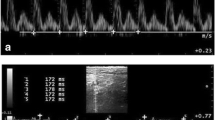Summary
In the present study, characteristics of the phasic flow pattern in the great cardiac vein and the mechanism of such pattern formation were investigated using a laser Doppler velocimeter with an optic fiber probe. The laser Doppler velocimeter allowed measurements of venous blood velocity under more physiological conditions than were possible with previous methods. Moreover, venous blood flow measurement in the great cardiac vein mirrors the effects of myocardial contraction on the venous flow more directly than does measurement in the coronary sinus. Thus, our method is considered very useful. Results obtained from the present study are as follows: 1) Measurement of the phasic flow in the great cardiac vein was made in 11 anesthetized dogs using our laser Doppler method. The blood velocity curve obtained in the great cardiac vein was always characterized by a prominent systolic flow wave (SFW). The mean value for the maximum velocities under control conditions in 11 cases was 40±13 cm/s. The blood velocity increased with the onset of left ventricular ejection and decreased gradually after the peak formation at mid- or late systole. — 2) Besides the above SFW, one or two small wave components were frequently observed during the atrial contraction period and/or during the isovolumic contraction phase. On the waveform during the atrial contraction period, two cases showed forward flow, while one case showed reverse flow. The small reverse flow waves during the isovolumic contraction phase were found in seven cases. — 3) Pharmacological interventions of dipyridamole and isoproterenol increased the maximum velocity. Compared with dipyridamole, isoproterenol accelerated the rate of rise in the SFW. — 4) No significant coronary venous flow was observed during the diastolic period prolonged by vagal nerve stimulation. However, after coronary vasodilator drugs were administered, there was a transient significant coronary venous flow during the prolonged diastole. This may be the overflow from the coronary capacitance vessels. — 5) During a reactive hyperemic response, the flow velocity of the great cardiac vein increased with the increment of the blood flow volume of the left anterior descending artery. However, its phasic change did not always correspond to that of intramyocardial pressure.
Similar content being viewed by others
References
Berne RM, Rubio R (1979) Coronary circulation. In: Berne RM (ed) The cardiovascular system, vol. 1. The heart. American Physiological Society, Bethesda, pp 873–952 (Handbook of physiology) Williams & Wilkins, Baltimore
Anrep GV, Cruickshank EWH, Downing AC, Subba Rau A (1927) The coronary circulation in relation to the cardiac cycle. Heart 14: 111–133
Imamura M, Hoki N, Kajiya F (1978) Fundamental investigation of blood flow measurement by laser Doppler method with optical fiber (in Japanese). Singaku Giho 78–59: 49–58
Imamura M, Kajiya F, Hoki N (1979) Blood velocity measurement by laser Doppler velocimetry with optical fiber. Proceedings of 12th International Conference on Medical and Biological Engineering, p 35
Kajiya F, Hoki N, Tomonaga G, Nishihara H (1981) A laser Doppler velocimeter using an optical fiber and its application to local velocity measurement in the coronary artery. Experientia 37: 1171–1173
Nishihara H, Koyama J, Hoki N, Kajiya F, Hironaga M, Kano M (1982) Optical fiber laser Doppler velocimeter for high-resolution measurement of pulsatile blood flows. Appl Optics 21: 1785–1790
Roberts DL, Nakazawa HK, Klocke FJ (1976) Origin of great cardiac vein and coronary sinus drainage within the left ventricle. Am J Physiol 238: 486–492
Wiggers CJ (1954) The interplay of coronary vascular resistance and myocardial compression in regulating coronary flow. Circ Res 2: 271–279
Scholtholt J, Lochner W (1966) Systolischer und diastolischer Anteil am Coronarsinusausfluß in Abhängigkeit von der Größe des mittleren Ausflusses. Pflügers Arch 290: 349–361
Stein PD, Badeer HS, Schuette WH, Glaser JF (1969) Pulsatile aspects of coronary sinus blood flow in closed-chest dogs. Am Heart J 78: 331–337
Bellamy RF (1981) Effect of atrial systole on canine and porcine coronary blood flow. Circ Res 49: 701–710
Mathey DG, Chatterjee K, Tyberg JV, Lekven J, Brundage B, Parmley WW (1978) Coronary sinus reflux. A source of error in the measurement of thermodilution coronary sinus flow. Circulation 57: 778–786
Kilpatrick D, Linderer T, Sievers RE (1982) Measurement of coronary sinus blood flow by fiber-optic laser Doppler anemometry. Am J Physiol 242: H1111-H1114
Tillmanns H, Steinhausen M, Leinbeger H, Thederan H, Kübler W (1981) Pressure measurements in the terminal vascular bed of the epicardium of rats and cats. Circ Res 49: 1202–1211
Klassen GA, Armour JA (1981) Epicardial coronary venous pressure. Can J Physiol Pharmacol 59: 1250–1259
Author information
Authors and Affiliations
Additional information
The present study was partially supported by a Research Scholarship of the Japanese Foundation of Cardiology
Rights and permissions
About this article
Cite this article
Kajiya, F., Tsujioka, K., Goto, M. et al. Evaluation of phasic blood flow velocity in the great cardiac vein by a laser Doppler method. Heart Vessels 1, 16–23 (1985). https://doi.org/10.1007/BF02066482
Issue Date:
DOI: https://doi.org/10.1007/BF02066482




